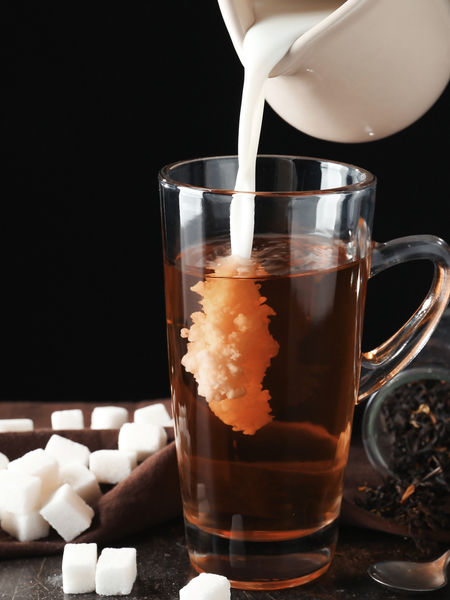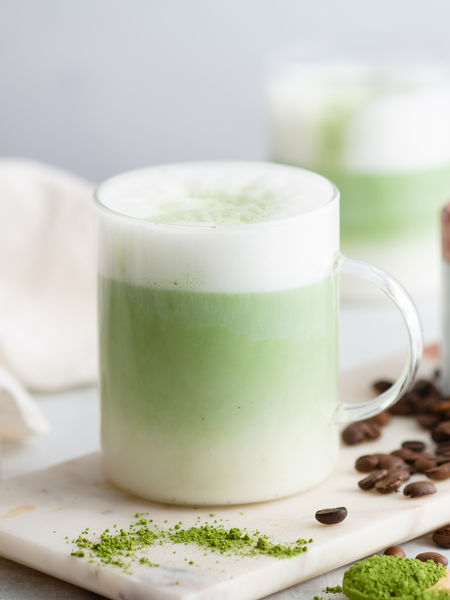Legen-Dairy: Guide to Adding Milk to Tea


Tea is the most popular beverage in the world, and because of that, there are many ways to prepare and enjoy it. While many people enjoy straight tea, a significant part of the tea world enjoys taking their tea with milk for a creamy, mellow beverage. Want to add some dairy to your tea diet? Here is what you need to know.
The Basics
There is a debate between those who enjoy the addition of dairy to their daily cup of tea and those who take tea in its purest form without additional ingredients. While many enjoy the full flavor a tea has to offer, pro-milk tea drinkers assert that milk softens the strong flavors of tea, making it less astringent and bitter as well as creating a smooth mouthfeel while sipping. Additionally, milk cools the tea down faster after brewing, allowing the sipper to enjoy the hot beverage sooner.
Tea drinkers can use whatever kind of milk suits their preference. 2% milk is a popular choice, with many fans swearing that it creates the best consistency for tea. However, whole milk is preferred for some teas, most notably Masala Chai which traditionally uses whole milk. While cow’s milk is popular, some tea drinkers like to add goat milk to their tea. Sweetened condensed milk is another alternative that is popular in various parts of the world. While some discourage the use of cream, a popular additive to coffee, others enjoy the thicker consistency that cream adds to their cup of tea.
When it comes to milk and tea, the ultimate goal is to make a cup of tea that you enjoy. There are guidelines to point you in the right direction, but there are few limits. Experiment with different types of milk and various amounts to customize your tea to your taste.
The Great Debate: Adding Milk Before or After Tea?
Ever since milk has been added to tea, a great debate has risen among the tea drinking population: should milk be added to the cup before or after the tea is poured? Historically, milk was added to the cup first to help prevent the cup from cracking from the hot temperature of the tea, but today, it’s up to personal preference. One thing most can agree on is to never pour the milk while the tea is brewing, which will disrupt the correct brewing temperature. The recommendations are that milk should be added to the cup first if tea is being brewed in a tea pot that will be poured out. If tea is brewed in a mug, then milk should be added once the loose tea or teabag has been removed. While you can risk adding too much milk to the cup if adding milk first, many insist that it can result in a smoother beverage. However, adding milk after the tea has been poured allows the enjoyer to add the correct amount of milk. Try both methods and see which works best for you.
What Teas Go Best With Milk
A popular practice in Great Britain, adding milk (as well as sweeteners such as sugar) to strong black tea mellows the flavors into a smooth beverage. These teas include Assam and the Breakfast teas (such as Irish, English, and Scottish). A more common practice in the US, adding milk to Earl Grey is rarely done in Great Britain with most tea drinkers only adding a little lemon or sweetener or nothing at all to the popular blend; nevertheless, adding milk to Earl Grey is acceptable.
Certain teas are traditionally brewed in hot milk. Masala Chai, for example, is traditionally made over a stove with a mixture of water, milk, tea, and spices in a pot, though there are variations on preparing it. While some prefer the intensity of a straight chai (with no milk whatsoever), most chai drinkers prefer it with milk and sweeteners to mellow the bold flavors present in a chai blend.
In a caffeine-free alternative (as well as one of the few herbal teas that can be enjoyed with milk), milk can also be added to Rooibos, a southern African herbal tea which was historically used as a substitute for black tea among Dutch settlers in the late 1800s. Rooibos is similar to black tea in taste and though milder, it takes milk and other additives well.
What Teas Are Best Without Milk
Although black teas are popular choices to add milk to, some exceptions should be enjoyed in their purest form without any additives. These teas are milder black teas whose flavors would be lost by the addition of milk and include Darjeeling (also known as the Champagne of Teas), Chinese black teas, or any long leaf black tea (typically longer than ½ inch). Pu-erh teas (another Chinese tea) are also recommended to be enjoyed straight.
While some like to add lemon, honey, mint, or sugar to them, Green and White Teas in general should not be prepared with milk. Like the mild black teas, the flavors of green and white tea are delicate and would become lost in a mixture with milk. Even a strong green tea like Gunpowder Tea (one of the main ingredients in Moroccan Tea) is served without milk. The rule especially applies to Japanese green teas, which shouldn’t even have sweeteners added to them. Although matcha lattes have seen a rise in popularity, a high quality matcha should never be mixed with milk and enjoyed in nothing but water.
Oolongs are another type of tea that should be enjoyed straight without any additives. A good oolong is intended to be brewed multiple times, with each subsequent brewing offering new, subtle flavors (with some oolong fans insisting that the second brewing is even better than the first). Adding milk to oolongs takes away this oolong experience and should be reserved for stronger teas.
